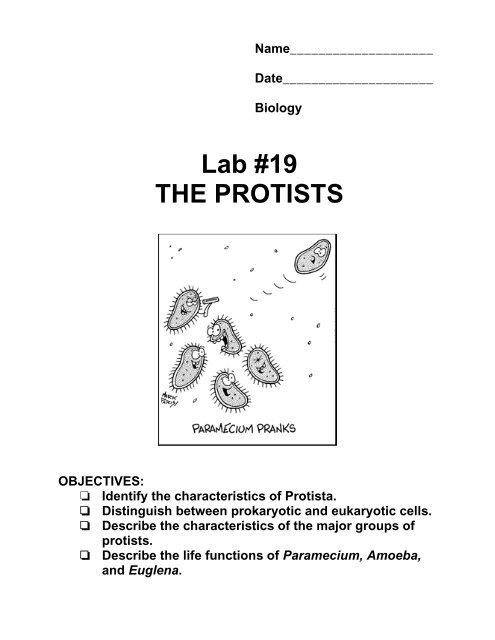Lab #19: The Protists - Naturebydesignlearning.com
Lab #19: The Protists - Naturebydesignlearning.com
Lab #19: The Protists - Naturebydesignlearning.com
You also want an ePaper? Increase the reach of your titles
YUMPU automatically turns print PDFs into web optimized ePapers that Google loves.
Name____________________Date_____________________Biology<strong>Lab</strong> <strong>#19</strong>THE PROTISTSOBJECTIVES:‘ Identify the characteristics of Protista.‘ Distinguish between prokaryotic and eukaryotic cells.‘ Describe the characteristics of the major groups ofprotists.‘ Describe the life functions of Paramecium, Amoeba,and Euglena.
<strong>The</strong> <strong>Protists</strong>QUESTION:What are the characteristics of Kingdom Protista?MATERIALS:Amoeba (prepared slide)cover slipEuglena (prepared slide)glass slidemedicine droppermicroscopepaper towelParamecium (prepared slide)pond water samplestoothpicksPROCEDURE:1. Study the diagram of the Amoeba provided. Draw a detailed picture of theAmoeba in the Data Section labeled Amoeba. Include all of the structureslisted below in your diagram.contractile vacuolefood vacuoleectoplasmnucleusendoplasmpseudopodium2. Now get a prepared slide of Amoeba and observe it under a microscope.Carefully observe the slide at low power, medium power, and if possible athigh power.3. Make a detailed drawing of at least 3 of the Amoebas found on the preparedslide. <strong>Lab</strong>el all structures you observe.4. Study the diagram of the Paramecium provided. Draw a detailed picture of theParamecium in the Data Section labeled Paramecium. Include all of thestructures listed below in your diagram.anal poremacronucleusciliamicronuleuscontractile vacuolemouth porefood vacuoleoral groove5. Now get a prepared slide of Paramecium and observe it under a microscope.Carefully observe the slide at low power, medium power, and if possible athigh power.6. Make a detailed drawing of at least 3 of the Paramecium found on theprepared slide. <strong>Lab</strong>el all structures you observe.7. Study the diagram of the Euglena provided. Draw a detailed picture of theEuglena in the Data Section labeled Euglena. Include all of the structureslisted below in your diagram.chloroplastnucleuscontractile vacuole paramylon bodyeyespotpellicleflagellumreservoir8. Now get a prepared slide of Euglena and observe it under a microscope.Carefully observe the slide at low power, medium power, and if possible athigh power.9. Make a detailed drawing of at least 3 of the Euglena found on the preparedslide. <strong>Lab</strong>el all the structures you observe.
10. Make up a wet mount slide of one of the pond water samples provided.Carefully observe the slide at low power and medium power. Try to find atleast 3 different protists in the sample. In the Data Section labeled Pond<strong>Protists</strong>, make a detailed diagram of each protist you find and identify thephyla to which it belongs.11. Make up a wet mount slide of one of samples containing algae. Carefullyobserve the slide at low power and medium power. Find at least two differentalgae samples and observe them carefully. Make a detailed drawing of eachalgae specimen in the Data Section labeled Algae Samples.DATA: AmoebaAmoeba DiagramPrepared AmoebaParameciumParamecium DiagramPrepared Paramecium
EuglenaEuglena DiagramPrepared EuglenaPond Water <strong>Protists</strong>Protist #1 Protist #2 Protist #3AlgaeAlgae #1 Algae #2
QUESTIONS:1. What are the characteristics of Kingdom Protista?2. What is the difference between prokaryotic cells and eukaryotic cells?3. What phyla make up Kingdom Protista?4. Why are Amoeba, Paramecium and Euglena considered eukaryotic cells?5. What characteristics do Amoeba and Paramecium have in <strong>com</strong>mon?6. Why is Euglena considered an autotroph?7. How does an Amoeba capture its food?8. What structures provide lo<strong>com</strong>otion in Paramecium?9. Compare and contrast the following phyla of Kingdom Protista by <strong>com</strong>pletingthe chart.PHYLACOMMONEXAMPLEMETHOD OFMOVEMENTAUTOTROPH ORHETEROTROPHRhizopodaCiliophoraZoomastigophora


